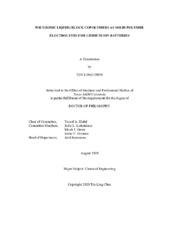| dc.description.abstract | Lithium ion batteries are currently the leading commercial technology for portable electronic devices and electric vehicles. However, shortcomings associated with its liquid-based electrolytes, such as leakage, flammability, toxicity, instability, and insufficient overall storage capacity, have limited the progress of the lithium ion batteries. Replacing liquid-based electrolytes with solid polymer electrolytes (SPEs) can alleviate many of these shortcomings, while offering other attractive properties, such as thin-film forming ability and flexibility. Of the SPEs that have been explored for lithium ion batteries, poly(ionic liquid) (PIL) block copolymers are one of the more intriguing materials, which allow for significant changes in physical properties with only subtle changes in chemistry. In this study, SPEs based on PIL block copolymers were developed and investigated for lithium ion batteries. Specifically, structure-property relationships of PIL block copolymer SPEs were systematically explored in relation to ion transport, self-assembled morphology, chemical, thermal, electrochemical stability, and battery performance.
A series of styrene-based PIL diblock copolymers and their analogous PIL homopolymers were synthesized with various ion pairs. This study explores the effect of lithium salt concentration and cation/anion chemistry on the physical, transport, morphological, and electrochemical properties. The result show that the cation/anion chemistry has a significant impact on transport properties, where significant property differences were observed with subtle chemical changes to cation/anion type.
In addition to binary polymer/salt SPE blends, ternary SPE blend was prepared consisting of a PIL multiblock copolymer, ionic liquid (IL), and lithium salt. Two different cations in the PIL block were investigated to understand the influence of cation structure. The results demonstrate that the PIL multiblock SPEs have high potential for lithium ion batteries with outstanding thermal and electrochemical stabilities, as well as high ionic conductivities. Additionally, the influence of IL concentration on ion transport mechanism and electrochemical stability in these ternary SPEs was investigated. Results show that the IL resides in the PIL phase-separated domains and increases the continuous conductive matrix for ion transport, as well as contributes to mechanical percolation. Lithium ion battery with this ternary SPE shows stable cycling performance over 100 cycles under room temperature. The results demonstrate the ion solvation and transport phenomena in ternary SPEs as well as enable the design of new SPEs for room temperature solid-state lithium ion batteries.
Overall, this work elucidated the chemistry-property findings of PIL block polymer SPEs and provides avenues to design and control the SPE with attainable high ionic conductivity and improved stability for the future solid-state lithium ion batteries. | en |


